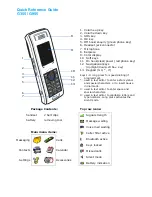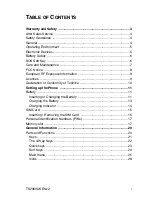
viii
Cisco Unified IP Phone 7960G and 7940G Administration Guide for Release 8.0 (SIP)
OL-7890-01
Preface
Objectives
Objectives
This guide provides necessary information to get the Cisco IP phone operational in a SIP network. It is
not intended to provide information on how to implement a SIP or a VoIP network. For information on
implementing SIP and VoIP networks, refer to the documents listed in the
“Related Documentation”
section on page ix
.
Document Organization
This document is organized into the following chapters and appendixes:
•
Chapter 1, “Product Overview”
—Describes the SIP protocol and the Cisco UnifiedIP Phone 7960G
and 7940G.
•
Chapter 2, “Installing Cisco Unified IP Phone 7960G and 7940G Hardware on the Desktop or
Wall”
—Describes how to install phone hardware.
•
Chapter 3, “Initializing Cisco Unified IP Phones”
—Describes how to install firmware, customize
configuration files, and connect the phone.
•
Chapter 4, “Managing Cisco SIP IP Phones”
—Describes how to upgrade firmware and perform
other management tasks.
•
Chapter 5, “Monitoring Cisco SIP IP Phones”
—Describes how to debug and troubleshoot.
•
Appendix A, “Compliance with RFC 3261”
—Provides reference information about Cisco SIP IP
phone compliance to RFC 3261.
•
Appendix B, “SIP Call Flows”
—Provides reference information about Cisco SIP IP phone call
flows.
•
Appendix C, “Technical Specifications of the Cisco Unified IP Phone 7960G and
7940G”
—Provides physical and operating environment specifications, cable specifications, and
connection specifications.
•
Appendix D, “SIP IP Phone Parameters”
—Lists and describes configurable parameters.
Document Conventions
This document uses the following conventions:
•
Commands and keywords are in
boldface
font.
•
Arguments for which you supply values are in
italic
font.
•
Elements in square brackets ([ ]) are optional.
•
Required alternative keywords are grouped in braces and are separated by vertical bars (for
example, {
x
|
y
|
z
}).
•
Optional alternative keywords are grouped in brackets and are separated by vertical bars (for
example, [
x
|
y
|
z
]).
•
Terminal sessions and information that the system displays are in
screen
font.
•
Information that you must enter is in
boldface screen
font.
•
Buttons and menus that are called out in text in an imperative context are in
boldface
font.









































